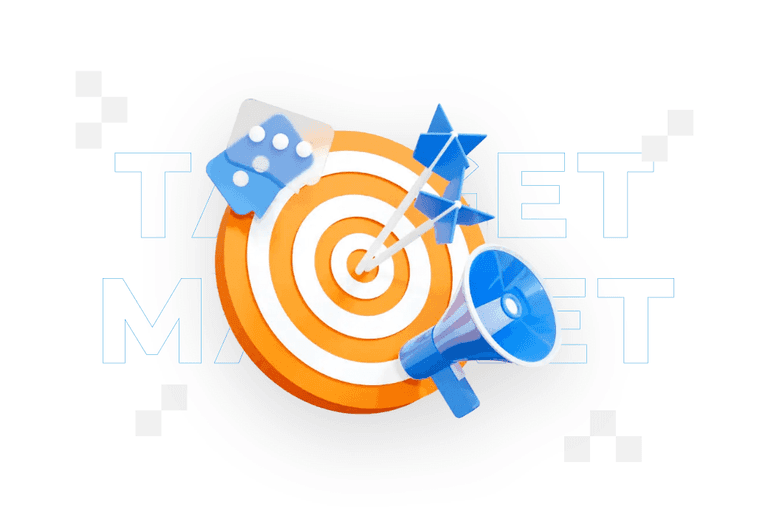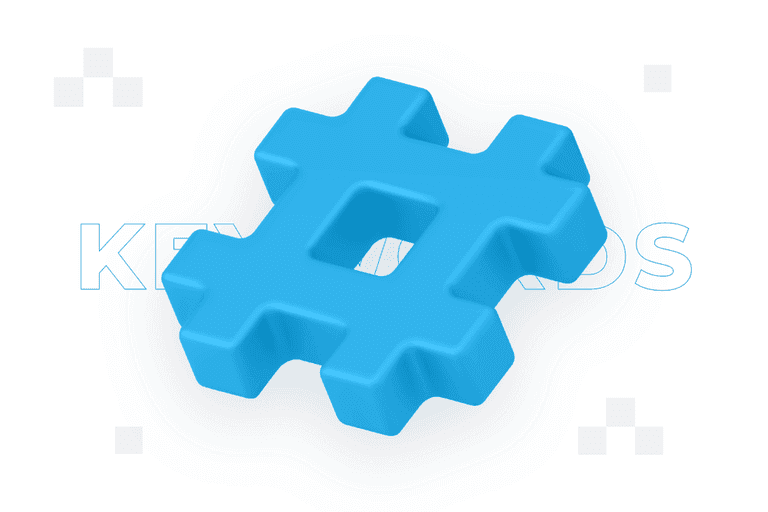
Target market – what is it and how do you find yours?

Every company, in order to operate effectively in the market, needs to define its target market. With it, it can fine-tune its products and activities to reach the potentially most interested customers.
From this article you will learn:
- What is a target market?
- What are the target market models?
- What is the difference between a target market and a target group?
- How are the sales funnel and target market related?
- What is market segmentation?
- How do you define the target market for your company?
- What are examples of target markets?
What is a target market?
A target market is a group of consumers on whom a particular company focuses its marketing efforts. These are the people who are most likely to be interested in purchasing your company’s products or services.
The target market is defined on the basis of various characteristics, such as:
- age,
- gender,
- geographical location,
- lifestyle,
- interests,
- income,
- behaviour.
Defining the target market is an essential step in developing an effective marketing strategy. It allows companies to better understand the needs and expectations of potential customers so that products, services and communications can be tailored to meet their needs and expectations.
A target market is a specific group of people or organisations that a company has identified as customers for its products or services. It is the group to which the company directs its marketing activities to meet their specific needs and expectations. It is characterised by certain demographic, geographical, psychographic and behavioural characteristics that differentiate it from other market segments. The selection of the target market is a key element of a company’s sales strategy and influences decisions on product, price, distribution and promotion.
Definition of the target market.
Target market models
Target market models allow companies to understand and define who their potential customers are. The decision to choose a specific target market model should be based on the company’s business analysis and strategy. The three most popular target market models are:
- Mass market model (undifferentiated marketing) – in this model, the company targets the entire market without segmenting it. An example would be a producer of basic food products such as rice or flour.
- Market segmentation model (differentiated marketing) – in this case, the company divides the market into several segments and then conducts marketing activities in one or more of these segments. An example of the application of such a model would be a car company producing different car models for different market segments, such as young families, elderly people, motorsport enthusiasts, etc.
- Niche market model (niche marketing) – in this case, one small market segment is identified where products or services are offered that are particularly attractive to this specific segment. An example would be a manufacturer of extreme sports equipment.
Target market vs. target group
| Target market | Target group | |
|---|---|---|
| Definition | A specific group of people or organisations to which a company targets its marketing activities, identified on the basis of certain demographic, geographical, psychographic and behavioural characteristics. | The segment of the target market whose characteristics, needs and expectations are most compatible with the company’s product or service offering. |
| Scale | Usually broader, encompassing the general range of potential customers. | Usually narrower, focuses on specific individuals or decision-making units within the target market. |
| Target | Used to determine the overall reach of a company’s marketing activities and to identify key market segments that may be interested in its offerings. | Used to focus on specific units or decision-making units that are most likely to purchase the company’s products or services. |
| Criteria | Based on a broad range of characteristics such as demographics, geography, psychographics and behaviour. | Based on more detailed and specific characteristics, such as detailed demographic, behavioural, psychographic and other data on specific individuals or decision-making units. |
| Use of | Used in strategic marketing planning to determine where and how a company should act to achieve its goals. | Used in tactical marketing planning to determine what products, services, prices, promotions and distribution channels will be most effective for specific units or decision-making units. |
Target market and target group are often used interchangeably in the context of marketing, but have slightly different meanings. The most important difference is the degree of detail – the target market is more general, the target group more specific.
The target market refers to a category of people, defined on the basis of specific factors (e.g. demographics, geography, lifestyle or interests), on whom a company focuses its marketing efforts. This is the group of potential customers who are most likely to buy your company’s products or services.
A target audience, on the other hand, refers to a specific, clearly defined group of people within a target market on whom a company focuses its marketing efforts at a given time or within a single marketing campaign. It is defined by more specific characteristics, such as life stage or purchasing behaviour.
For example, a clothing company might define its target market as ‘women aged 20-50’. Within it, it may have several different target groups for its various product lines – ‘young professionals aged 20-30 who are looking for smart clothing for work’ or ‘women aged 40-50 who are looking for comfortable but stylish casual wear’.
Target market versus sales funnel
The target market and the sales funnel are two different but related concepts in marketing and sales. The target market is the group of consumers to whom a company targets its marketing activities. The sales funnel, on the other hand, is a model illustrating the process a customer goes through, from initial interest in a product or service to the final purchase (and sometimes post-purchase). The sales funnel typically has several stages, which may include:
- Awareness (Awareness) – the customer learns about the product or service.
- Interest (Interest) – the customer starts looking for more information about the product or service.
- Consideration – the customer begins to compare the different options available in the market.
- Decision – the customer decides to purchase the product or service.
- Action – the customer makes a purchase.
- Loyalty (Loyalty) – the customer becomes loyal to the brand and may make further purchases.
The sales funnel is used to plan and optimise marketing and sales strategies. For example, your company may use different strategies and tactics at different stages of the funnel to effectively attract, engage and convert its target markets. From this, it follows that a company uses information about its target market to plan and optimise activities at each stage of the sales funnel.
What is market segmentation?
Market segmentation is the process of dividing the overall market into smaller, homogeneous groups (segments) distinguished by similar characteristics, needs, preferences or lifestyles. This allows us to understand the differences between groups of consumers in order to better tailor marketing strategies to the specific needs and expectations of each segment. Each market segment is defined on the basis of various criteria, such as:
- demographic, such as age, gender, income, education, occupation, household size,
- geographical, such as country, region, city, climate, population density,
- psychographic, such as lifestyle, personality, values, interests,
- behavioural, such as benefits sought, willingness to buy, brand loyalty, how the product is used.
Once the market has been segmented, the company selects one or more to which it directs its marketing activities – these constitute the company’s target market. It is then necessary to tailor products, services and communication strategies to the specific needs and expectations of its target market.
Market segmentation helps a company understand who its potential customers are, what their needs and expectations are, what communication they might prefer, etc. Without it, your company could be wasting resources trying to attract the wrong customers or failing to meet the needs of the right customers.
How do you determine the target market for your company?
Identifying the target market for your business is a key part of your marketing strategy. Remember that this process should be based on solid data and market research, not just intuition or conjecture. The target market is most often defined using the following steps:
Product or service analysis
A proper understanding of what your business offers allows you to better identify your Unique Selling Proposition (USP) and who might be interested in your offering and why. To do this, it is useful to clearly identify the physical features of your product or the features of your service. If you sell bicycles, features such as size, weight, frame material or type of brakes may be important to the customer.
At this stage, it is also worth pointing out the benefits to the customer. They may be functional (e.g. a bicycle provides fast transport), emotional (e.g. cycling gives a feeling of freedom), social (e.g. cycling is seen as environmentally friendly) or personal (e.g. a bicycle looks good).
At the same time, it is good to indicate what problems your product or service solves for customers. For example, a bicycle may solve a problem with public transport (no congestion, no delays), health (enables exercise) or the environment (zero emissions). Each time, it is a good idea to clearly define what unique added value your product or service provides. This could include quality, price or design, among others.
Customer research
Customer research helps you understand who is currently using your products or services (or who might be interested), what their needs and expectations are, what characteristics and behaviours they have, and why they choose (or don’t choose) your offering. When researching customers, it is important to identify their demographic, geographical, psychographic and behavioural characteristics, as well as their needs and expectations.
At this stage, it is also important to identify why customers choose your products/services. Gathering and analysing this information will help you understand your current and potential customer base, which is key to identifying your target market. Also remember to survey your customers regularly, as their needs, expectations and behaviours may change over time.
Segmenting and selecting your target market
Market segmentation involves dividing the broad market into smaller, more homogeneous groups (segments) of customers who have similar needs, preferences or characteristics. Remember that the purpose of this activity is to identify the most attractive and accessible segments for your business. Each should be large enough to be profitable and different enough from the others to require a specific marketing strategy. Once identified, you can select one or more segments to become your target market.
Selecting a target market is a key step in the marketing process. Once you have segmented your market based on demographics, geography, psychographics and behavioural characteristics, it is time to select one or more that will become your target market.
During this process, first of all assess whether the segment is large enough to be profitable and determine its growth potential. Valuing the potential will help you determine whether it is worth investing in.
Also assess whether you are able to effectively reach your chosen segment through the available marketing channels. Its accessibility is crucial to the implementation of your marketing strategy. It is equally important to check whether your product or service meets the needs and expectations of the selected segment. The more compatible it is with your offer, the greater customer satisfaction and loyalty to your brand can be.
Also check the competition in your chosen segment. Are you able to compete with other companies? Competitor analysis can help you understand what your chances of success are. Remember, too, that in selecting your target markets, it is advisable to use a strategy that focuses on niches that are ‘less crowded’ but still show sufficient potential and accessibility.
Creating a target market profile
A target market profile helps you understand who your target customers are, what motivates them and what their needs and expectations are. To create it, describe the key demographic, geographical, psychographic and behavioural characteristics of your target market. Then identify the main needs and expectations of your customers in relation to your product or service.
An important part of creating a target market profile is to determine the best ways to communicate with the people who make it up. You need to clearly identify which channels they may prefer and develop a marketing strategy based on this. If your target market consists of younger audiences, communicating on social media or through video marketing may be an effective solution. For older ones, traditional forms of advertising may work better.
Remember that your target market profile should be dynamic and updated based on new information and research. In this way, you can be sure that you always have accurate information about your target market, which will allow you to better adapt your marketing activities.
Testing and adapting
Identifying, selecting and presenting your offer to your target market is not the end of your activities. In order for their effectiveness to grow over time, they need to be tested and adapted regularly. You should check that your assumptions about your target market are correct and that your offer and marketing strategy effectively meet their needs and expectations. You can conduct market research for this purpose or try out new products, services, promotional strategies or distribution channels.
Just as important as experimenting with your offer is analysing the results. Remember to use specific and measurable indicators and continuously analyse your sales, return on investment (ROI) or customer satisfaction levels. On this basis, you can adjust your marketing strategy to better meet the needs and expectations of your target market.
Remember that your target market and its needs and expectations may change over time. It is therefore important to regularly update your target market profile, market research, testing and adjustments.
Examples of target markets
Remember that the target market is usually defined in detail, taking into account various characteristics such as demographics, geography, psychographics and behavioural. This is crucial for creating an effective marketing strategy that meets the specific needs and expectations of the target market. Below are some examples of target markets:
- Educational toy manufacturer company – target market is young families with children aged 3-8 who value learning through play.
- An organic food shop – in this case, the target market is people aged 25-55 who live in urban areas, have a healthy lifestyle, care about the environment and are willing to pay more for organic products.
- Luxury sports car manufacturer company – the target market is affluent individual customers, typically men aged 30-60, who are passionate about cars and value prestige, performance and quality.
- A classical music streaming platform – will target people aged 30 and older who have a background in music or are big fans of classical music.
- A home care company for seniors – in this case, people aged 60 and older who need help with daily activities, or their families who are looking for reliable care services, may be most interested.
- A youth streetwear brand – young people between the ages of 15 and 25 who are up to date with the latest fashion and music trends and whose lifestyle is linked to street culture may be interested in the offerings of such a company.
Contact form
Develop your brand
Rate content:
You may be interested in:




